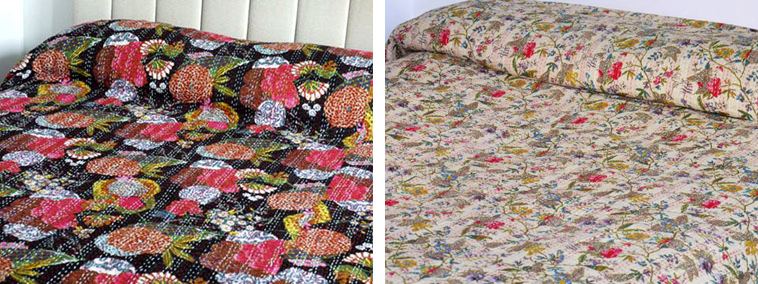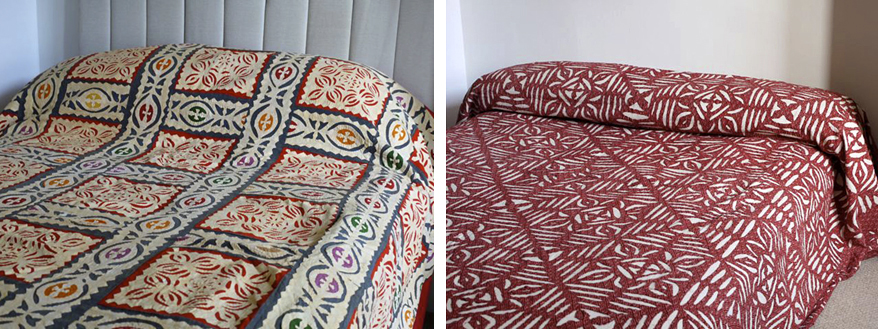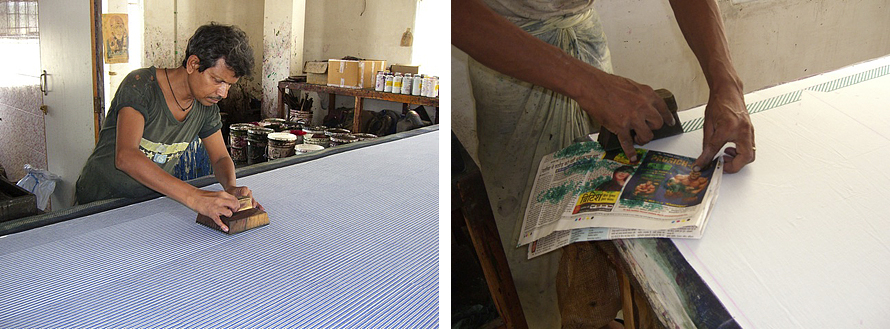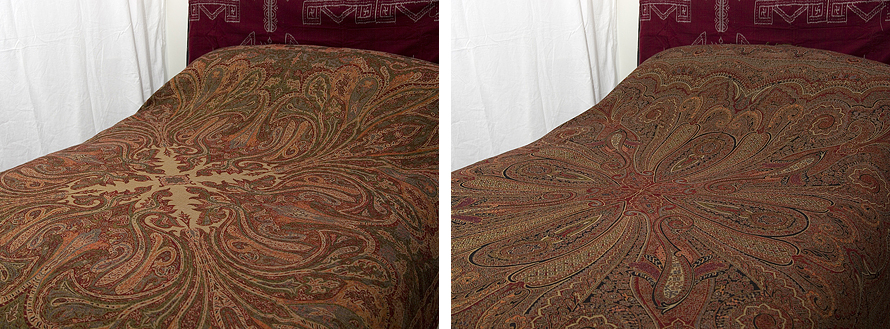Indian Bedspreads
Indian bedspreads reflect how Indian domestic interiors are generally of the utmost simplicity, with hardly more than a carpet or a prayer mat to offset stone floors and plain white walls. But strangely enough Indian textiles have played a significant role in the history of Western interior design. Words of Indian origin such as calico, chintz, and madras bear this out, yet Indians themselves have never been very conscious of this role. There are many types of Indian bedspreads.
New Kantha stitched Bedspreads are two pieces of cotton fabric, one side printed, sewn together with a running stitch called kantha. Unlike the vintage kantha throws or quilts these are made from new cotton material and therefore can be made into different size bedspreads. I have examples on my website of Paradise, Dalia, Tropical Flower and Ikat designs.


Kantha Indian bedspreads – available in King, Queen or Single size – from £65.00
Applique Indian Bedspreads are made up of two layers of material – the base layer can be made of plain cotton or organdie and the top layer is cut into patterns or motifs and then stitched on top of the base layer. There are several different styles of stitching used for appliqué work and sometimes tiny mirrors are used in the pattern. My website shows both white and coloured Applique bedspreads from Orissa and Gujurat.


Applique Indian bedspreads – available in King, Queen or Single size – from £55.00
India has been renowned for the block printing craft since the 12th century and this technique is often used for Bedspreads. The printer’s main tools are the carved wooden blocks, called ‘bunta’. The blocks are generally made out of seasoned teak. The underside has been carved into a relief pattern with great dexterity and the resulting patterns are often very intricate and delicate. Each block has a wooden handle and several holes that have been drilled into the block to allow for the passage of air and the movement of any excess printing pastes.
The fabric to be printed is then stretched over a table and pinned down. The block is dipped into a tray of colour and then pressed down hard onto the material to ensure a good clear print. There is a point on the block that aids the placement of the next pattern so that the accuracy of the repeat pattern is maintained.


Hand block printing


A selection of hand block printed bedspread patterns – – available in Queen or Single size – from £45.00
Jamawar, woven in the softest wool, is made in the northern regions of India, Himachel Pradesh and Kashmir. “Jama’ means robe and “war” is yard. Most of the designs seen today are floral with paisley the most dominant motif. Historically handmade shawls took a couple of decades to complete and consequently, original Jamawar shawls are very expensive. Jamawar weaving by handlooms is intricate and the process is very time consuming. It is made with weaving sticks and the patterns are so finely done that the front and back of the shawl are indistinguishable and there can be as many as 30 colours in one piece. The colouring is done by the ‘colour caller’ with a black and white drawing before him, beginning at the bottom and working upwards, calling out each colour to the weavers, and also the number of warps along which it is required until the pattern is covered.
These patterns are then turned into a coded design that the weavers can decipher and they guide others by calling out aloud the number of warp ends to be covered in a particular coloured weft. A second weaver sits on the loom to accelerate the process and the chief weaver recites the weft repeat for him to follow. You can find the Jamawar bedspreads on my website.


Jamawar Indian woollen bedspreads – available in Queen size, priced at £190.00
Click here to return to the main Bedspreads page.







